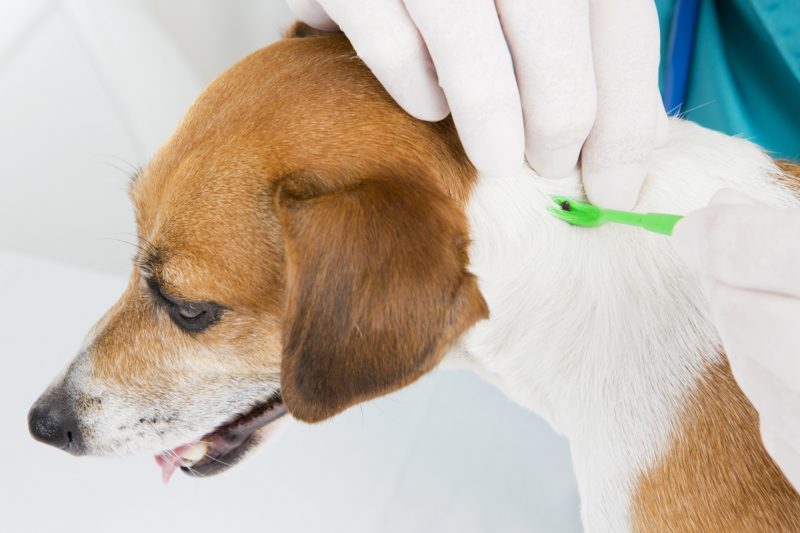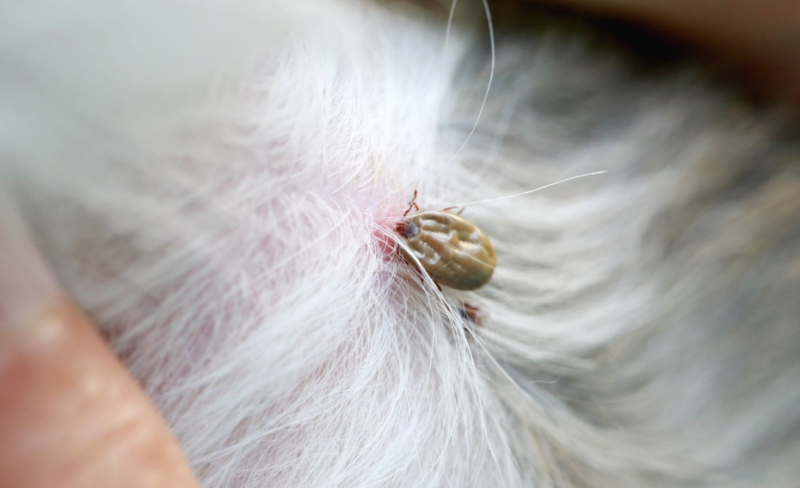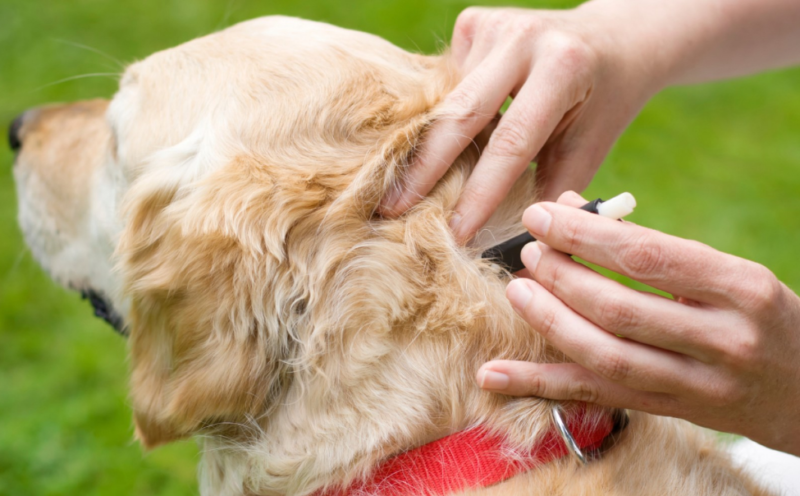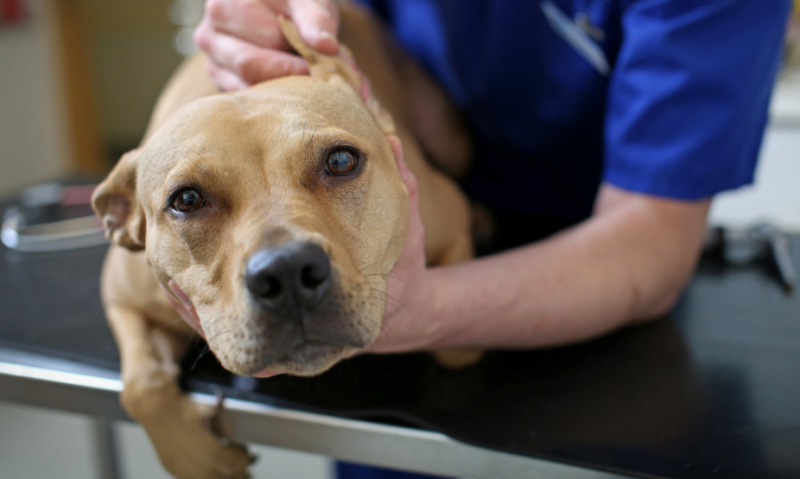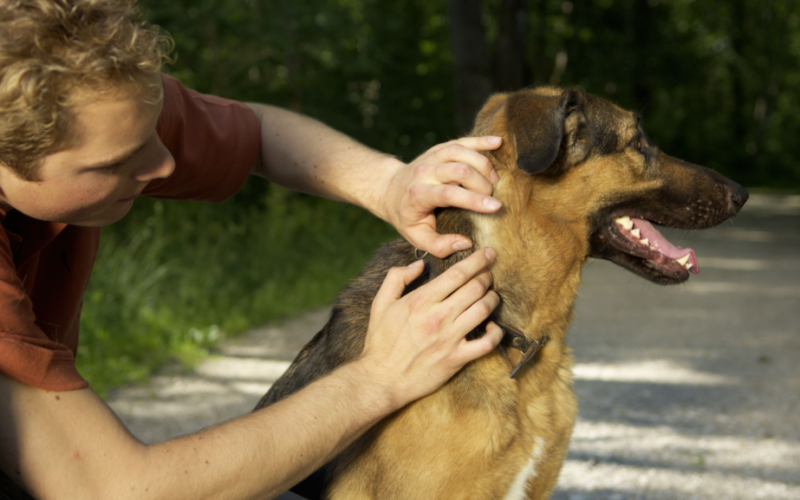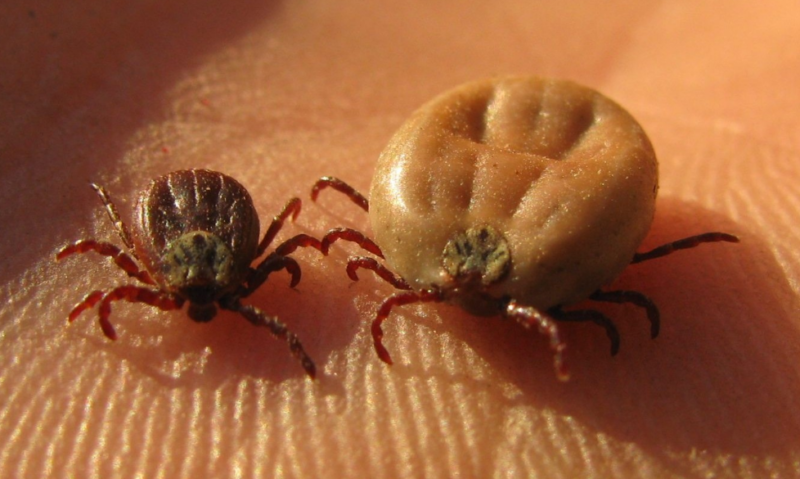With the onset of spring heat, dog owners should be especially vigilant. Indeed, it was during this period that a small, but extremely dangerous creature, a tick, entered the hunting trail. How to protect yourself and your pet from his attack, and what to do if a dog is bitten by a tick?
Material Content:
What does a tick look like
The most common and dangerous variety of ticks parasitizing on dogs is the ixodid tick. This arachnid is quite shallow - up to 5 mm in length. The color of his body varies from brown to brownish. The dog is able to "catch" the tick during walks in the forest, swamp or field. In attempts to find a parasite, first of all, you should examine the head, ears, abdomen and limbs of dogs, since these zones are favorite locations of ticks. When sucked, it resembles a bloated pea of a light yellow or grayish hue.
Characteristic bite symptoms
When a dog is bitten by a tick, it can be tracked for a number of symptoms. So, the animal often behaves uneasily, shakes its head when the tick climbed into the ear, and also scratches the site of the bite. Often, at the place from which the tick was removed, after 2-3 hours there is a bright redness, gradually passing on its own.
The main skin reaction to the parasite is an allergy. In general, the intensity of symptoms depends on the type of tick, as well as the degree and duration of its suction.
Particular attention should be paid to symptoms such as swelling of the bite, which increases from the center, as well as redness, pain and itching, fever. The dog in every possible way tries to lick the damaged place. Sometimes granulomatous dermatitis appears on the skin of an animal a day after a bite.
When a lump appears in the affected area, this may be a symptom of an allergic reaction to the bite. Purulent inflammations are also common, which are formed when microbes are applied to an open wound. The bump often swells if the head of the parasite remains in the wound. This situation is especially dangerous, because the insect can begin to decompose, which will provoke blood poisoning.
As a rule, the symptoms of a tick bite appear 6-10 days after the attack. However, there are situations of fleeting development of the disease.
Additional symptoms of a tick bite in a dog:
- thirst;
- apathy;
- drowsiness, lethargy;
- dyspnea;
- shiver;
- unpleasant smell from the mouth;
- shaky gait;
- the inability to swallow food;
- lack of ability to bark;
- diarrhea, vomiting.
Tip. It is worth paying close attention to the body temperature of the dog. A figure of about 38.5 ° C is considered normal.
An increase in temperature to 41–42 ° C can be triggered by a mite lesion. Indicators should be measured in the anus of the dog.
What to do if a dog has a tick
What should be the actions of the owner, who discovered a tick on the skin of his pet?
Before visiting a veterinary clinic, at home, you should take three steps:
- remove the tick immediately;
- treat a bitten place with an antiseptic;
- observe the behavior of the animal, tracking possible infection.
You can remove the tick from the dog as follows:
- Form a noose loop from a strong thread.
- They throw it on the body of the tick at the very base of the head, fix it.
- The loop is slowly rotated counterclockwise, removing the bloodsucker.
- The wound is treated with iodine or an antiseptic.
The seized tick is placed in a resealable container. If subsequently the dog has signs of the disease, the parasite is given for examination. Not all ticks carry the infection and not all of them are dangerous to animals. But the degree of harmfulness cannot be tracked only through special research.
How is pyroplasmosis treated?
Pyroplasmosis (babesiosis) is a common disease, often affecting animals that have been bitten by a tick. The disease spread by the parasite is dangerous due to its ability to destroy red blood cells (a decrease in their number is clearly monitored in a blood test).
A dog may be ill with pyroplasmosis after being bitten by a parasite for 4 to 15 days. The sooner typical symptoms have been detected, the more likely the animal is to survive and recover. With a very rapid course of the disease, the dog can die without any traceable signs of pathology.
Tip. To track babesia, you should contact your veterinarian. This disease must be differentiated with similar ailments: plague, leptospirosis, poisoning.
The specialist must conduct urine and blood tests of the four-legged patient.
Treatment of piroplasmosis in dogs includes the following steps:
- The use of antiparasitic drugs: "Veriben", "Berenil." Stronger drugs include Imidocarb, Piro-Stop.
- The use of diuretics, as well as glucose, vitamins.
- Alkalization of urine. It is necessary to adjust the functionality of the kidneys of the animal. To this end, sodium bicarbonate is administered intravenously to the dog, which stops the blockage of the kidney tubules. The dog is also watered with a soda solution (2 g of soda per 10 kg of dog weight). It is permissible to replace soda with the Blemaren drug (per day the animal is given 1 tablet per 10 kg of weight).
After complete recovery, the animal must observe motor rest for another 2 weeks. Also, the pet needs a special diet and care.
Tick-borne encephalitis in a pet
Tick-borne encephalitis is a disease equally dangerous for animals and humans. As a rule, after a bite of an encephalitis tick, the dog has severe symptoms: cramps, hyperthermia, impaired movement and even paralysis. The main symptom of the disease is the acute sensitivity of the neck and head, pain in this area.
The incubation period lasts about 2-3 weeks.
- During treatment, the animal is prescribed antibiotics Isoniazid, Pefloxacin, Rifampicin, and Chloramphenicol. These drugs have a strong toxic effect on animals. More sparing options for medicines are Tienam and Ceftazidime.
- Also, sick animals are prescribed antispasmodics and drugs to lower the temperature. In addition, the methylprednisalon corticosteroid and medications that reduce intracranial pressure can be recommended: Diacarb, Mannitol.
- Vitamin complexes are also prescribed for the sick animal.
Sick and recovering dog food
During the period of illness after a tick bite, the dog needs special nutrition. The diet should be planned taking into account the condition of the animal. When the dog is weak and turns away even from the most beloved treats, the veterinarian can prescribe nutritious droppers. At the same time, it is strictly forbidden to feed the dog with force, because food can become a strong load on a weakened body.
When the appetite is preserved, the dog is fed several times a day in small portions.
The diet of animals with pyroplasmosis is agreed with the veterinarian. As a rule, dogs are allowed mashed potatoes and cereals (buckwheat, wheat, rice). In this case, the meat should be lean (lamb, beef, turkey).
If the pet eats dry food, it must be soaked in water to the consistency of pulp, and mix canned food with hot water (the food should be warm).
If the cured animal does not eat, moves constrainedly - this may be a sign of pancreatitis, which developed as a result of pyroplasmosis. If the veterinarian has determined that hepatic function is impaired, the pet should be given dietary meat (turkey, chicken, rabbit), ground cereals, and some stewed vegetables. Food should be semi-liquid and a little warm. If the pet has damaged kidneys, it is also worth abandoning heavy proteins and fats. Fish should be given in moderation, exclusively in boiled form or discarded altogether. Porridge and soups should be cooked on the second broth.
The consequences of a tick bite
A tick bite can be extremely dangerous for pets, as it bites an animal’s skin and infects the infection, and the wound remaining after a bite can also take on an environmental infection.
The consequences of a tick bite can provoke multiple troubles with the health of the pet, right up to the most sad outcome. Pyroplasmosis is only one of the diseases spread by the tick. The pet can also be infected with borreliosis, which can lead to partial or even complete damage to the joints and subsequent lameness.
Prevention methods
Even the most thorough prevention does not give one hundred percent protection against ticks, but with its help you can reduce the risk of attack of these parasites.
First of all, you should choose places for walking. And although the tick can attack even in unexpected places, you need to limit visits to forests and parks at the peak of parasite activity - in August - September and April - May.
But even walking around the courtyard and squares, the dog can "pick up" the tick. Therefore, it is necessary to carefully examine the body of the animal after a walk.
No less relevant is the use of so-called acaricidal agents. In veterinary pharmacies, various drugs that protect against ticks are sold in the form of a spray, drops and even special collars.
Are dog ticks dangerous for humans?
Should a man be afraid of ticks parasitizing on dogs? Two species of these creatures are considered dangerous to humans: brown dog and taiga.
- The first is often found in flower beds, in mixed forests or coniferous forests. Often the tick is transmitted to the owner from the pet. The parasite sticks for a day or two.
- The taiga tick is found in dense forest thickets, stretching from the Far East to Eurasia itself. He lies in wait for his victims, hiding in the bushes and grass.
Both parasites are carriers of tick-borne encephalitis, borreliosis, paralysis, tularemia and other bacterial infections that can be transmitted to humans through a sick animal.
All of these diseases are difficult to cure, because they are not easily diagnosed. For this reason, people should be vigilant in contact with animals, especially during tick activity.



